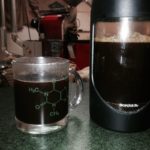How to Make Every Day National Coffee Day
Here at Wood-Fire Roasted Coffee Company, we celebrate National Coffee Day every day.
We believe coffee is a beverage worthy of commemorating daily, not just once a year. For many of us, preparing and sipping coffee is a ritual. It allows our mornings to run smoother, perks our afternoons up, and provides the last flavor our mouths relish after our evening meal.
So that you too can make everyday Coffee Day, here are some tips to prepare the very best cup you can:
Beans
• First, begin with 100% whole Arabica beans. These beans brew the finest quality coffee.
• What’s your preferred flavor profile?
Do you like the fruity, botanical notes of light-medium roasts? More of the chocolatey, nutty notes found in darker roasts?
Choose your favorite profiles and then find your best coffee fit.
• Grind the beans just before you brew, preferably in a Burr grinder, which provides exceptional coarseness or fineness and consistency for preparing perfect, or as close as you can get, coffee.
Grind fairly coarsely if using a French Press or pour-over system like Chemex™. For espresso machines, use a fine grind. While we don’t recommend drip coffeemakers, if using one, use a medium grind.
• Remember, if you like “weak” or “strong” coffee, it’s not about the roast or beans, it’s about how you prepare them.
Water
• Whatever your brewing method, the water needs to be the correct temperature to extract the mouthwateringly flavorful volatiles, while avoiding any bitter notes.
Boiling point at sea level is 212° Fahrenheit. As the USDA states, “With each 500-feet increase in elevation, the boiling point of water is lowered by just under 1° F.”
Using that equation, boiling point at 5,000 feet is approximately 200° Fahrenheit.
• Boil the water until it reaches between 195° and 205° Fahrenheit. Temperatures below that may not draw out the most palatable compounds, anything higher may scorch the beans, adversely affecting the flavor.
Brew
• Once you’ve decided upon the beans, pick your brewing method and grind appropriately.
Consider the following:
o Devices requiring a paper filter such as pour-over systems will absorb many of the acidic, bitter-tasting lipids present in coffee. If you prefer a crisper mouthfeel from your cup, use this method.
o Conversely, French Presses use no paper filters, and therefore allow all solubles present in the beans to come through. This results in a creamier more viscous mouthfeel.
• Wood-Fire Roasted Coffee Company’s Owner/Roaster Tim Curry feels coffee perfection is achieved with a brewing ratio of 15:1, meaning adding one part coffee to 15 parts water. For example, adding six ounces of water to two tablespoons of ground coffee provides that 15:1 balance.
• If you prefer “strong” coffee, add a bit more grounds. Folks liking weaker coffee should add off boiled water to their cup after the coffee is brewed.
• Allow your beans to bloom before adding all of the water. Pouring a bit of the hot water over the grounds, then agitating them slightly and allowing them to bubble for about 30 or so seconds helps release any of the residual, post-roasting CO2 remaining within the coffee which prevent water from getting to the delectable solubles inside.
Once the bubbling action stops, you’re ready to add the rest of the water.
• Let the water steep into the grounds for approximately three to four minutes, then discard the paper filter or depress the plunger and enjoy your cup of delicious, self-prepared, caffeinated mastery!
Contributed by Natasha Bourlin of Passport and Plume



